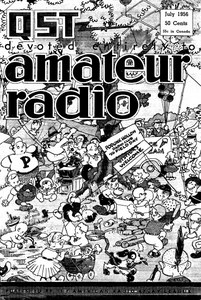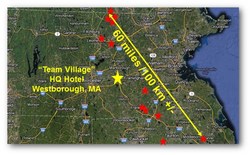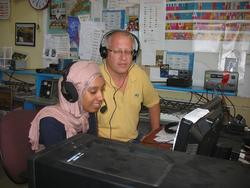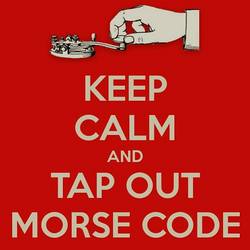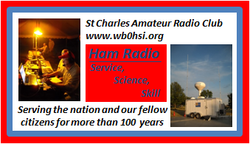 July 17, 2013 Editor: Ward Silver, NØAX | |||||||
IN THIS ISSUE
NEW HF OPERATORS - THINGS TO DO Have you tried mobile operation? Why not throw a whip on your vehicle and have some fun activating counties in the MARAC US Counties QSO Party? Surely there is a little-visited, lightly-populated county within driving distance? If not, the RTTY version of the North American QSO Party is coming up and for island fans, the annual Islands On the Air (IOTA) contest is right around the corner. BULLETINS The National Scout Jamboree began on July 15th and runs through the 24th. Listen for K2BSA on the bands - more information in Web Site of the Week below. BUSTED QSOS No corrections needed this time. CONTEST SUMMARY Complete information for all contests follows the Conversation section July 20-21
July 27-28
With the Worked All Europe (WAEDC) contest on its way - August is host to the WAEDC CW weekend - a very interesting feature of WAEDC could use some discussion. Of course, I'm referring to the exchanging of QTC - log excepts - between stations during the contest for extra points. QTC can be intimidating the first time you encounter it (you can always just say no but giving it a try might be fun) so the WAE Manager, Helmut DF7ZS and the World Wide Radio Operators Foundation (WWROF) have teamed up to present a video called "WAEDC - A True Blue DX Contest and the Thrill of QTCs" on July 20. You can register to watch the video live or you can watch it from the archived video selections later. (Thanks, Ken K4ZW)
The popular website known as "Mods" is a terrific site for finding information on improving or (obviously) modifying your equipment. They have added a "Homebrew" feature to publish your own construction articles and the upload/download process has been streamlined, as well. While the site is a subscription site, non-members may download one article per day. (Thanks, Jerry VE6CPP) The July issue of the free 432 MHz and Above EME Newsletter is now available as a Word or PDF file. Previous editions are also available from the newsletter archives. (from AMSAT bulletin ANS-188) Chris G4HYG has just released a new APRS app, APRS Messenger, for Android phones and tablets that sends APRS position beacons and messages from an Android-equipped phone or tablet over a 3G or Wi-Fi link to the APRS-IS internet system. It can also link to the new Bluetooth-enabled version of the APRS TNC Digi Tracker. Chris notes that there is a small charge for the app that helps pay for the development tool licensing fee. (from AMSAT bulletin ANS-188) The local media is starting to pick up on next year's WRTC-2014 in the Boston area. This story in the Lowell, MA Sun captures the spirit well as it describes the testing and checkout process that was occurring during this weekend's IARU HF Championship.(Thanks, Trent VK4TS) Here's an interesting take on design that has some applicability to radios and electronic equipment. I'm sure we all have gadgets with impressive technical specifications but that are difficult to use or enjoy. The article "People Over Megahertz" talks about considering the operator before designing the product. Web Site of the Week - Not to be confused with Jamboree On the Air, which occurs in October, the National Scout Jamboree is running right now - through the 24th of July. Organizers of the K2BSA station at the jamboree hope to get 4,000 Scouts through the demonstration station during the Jamboree and need hams on the other end of the QSO to engage the Scouts in conversations about ham radio and Scouting. Why not turn on the rig and work a scout? (Thanks, Jim K5ND) WORD TO THE WISE Weak signal - referring to CW/SSB on the VHF+ bands, the word "weak" doesn't necessarily mean that the received signal is weak. It refers instead (roughly) to the ability of a mode to achieve a useful signal-to-noise ratio in a given bandwidth. Stated more simply, CW and SSB "do better" when signal levels are low because their power is concentrated in a narrower bandwidth than FM. This enables contacts over longer distances via CW and SSB, all other things like transmitter power and antenna gain being equal. The tradeoff is that FM has better noise-immunity, which is more important for regional communications.
The WRTC-2014 organizers were hard at work before, during, and after the IARU HF Championship contest this weekend. Imagine setting up 25 high-performance, Field Day 1A SO2R stations - and that's just a dry run for next year's 65! Several videos and photo albums have been circulating - here's a few:
(Thanks, WRTC-2014 Co-chair Randy K5ZD, Dave KM3T, and Will, K6ND) Nigel G3TXF has posted some "Ham Radio 2013" photos from the big Friedrichshafen hamfest. Put some faces with those calls that are in your log so many times! (Thanks, Daily DX) The capacities of Antique Radio Museum in Fairhaven, WA (near Bellingham) have been transformed - your editor has induced that you won't be able to resist this interesting video about the museum's new name "The Spark Museum of Electrical Invention"! You may have known its previous name, "American Museum of Radio and Electricity". (Thanks, Scott KG7GX) While you're sweltering in the summer sun, this web story about radio in the Arctic just might help cool you off! (Thanks, Ken KØPP) Results of the 2012 Russian Radiosport Team Championship (a WRTC-style competition) are available along with a selection of photos from the stations in the field. The RRTC-2013 is this weekend with stations using call signs in the R31A-R39Z series. (Thanks, Valery R5GA) Qualifications standings for WRTC 2014 have been updated. There are only four more contests to come - NAQP CW and SSB in August and NA Sprint CW and SSB in September!
The results of the 2013 UBA DX Contest SSB are now online. Contest certificates can be downloaded as well - be sure to enter you exact call sign as in the contest. (Thanks, Marc ON7SS/OO9O) The final results of the 2012 YO DX Contest are also online. (Thanks, Alex IV3KKW) OPERATING TIP As openings along polar paths remain sketchy due to low solar activity, don't forget about skew path - a propagation phenomenon in which ... contacts can be made by aiming your antenna closer to the Equator (a more easterly or westerly heading). This means that the first hops travel in a more southerly direction (for northern hemisphere stations). For a North American station, for example, a skew path opening to Japan might result in signals peaking due west or even south of west. Skew path openings can take place at frequencies below the maximum usable frequency (MUF) along the great circle path, which is often the case under poor propagation conditions. Turning your antenna to explore skew path propagation is avery useful technique that can make a previously inaudible signal suddenly appear and make a QSO possible. (From the Contest University Glossary by Pat N9RV) Lots of projects need some kind of temperature sensing - such as amplifiers and power supplies - to keep a watchful eye out for overload. Along with the venerable LM34 and LM35 sensor ICs (which output temperature in mV per degree C or F) Manfred XQ6FOD recommends other options: "There are some digital temperature sensor chips, like the DS18S20. You can connect several of these sensors using a single wire and program addresses into the sensors to access them selectively. Thermistors, which don't tend to rectify RF, exist in PTC and NTC versions...they are very non-linear. Also look at Pt100 and Pt1000 sensors. They are almost linear, highly accurate, RF-insensitive, and exist in many physical shapes but their output signals are small, so a lot of amplification is needed. Don't overlook plain diodes and (bipolar) transistors (such as a 2N2222) as temperature sensors. A transistor connected as superdiode (joining base and collector) is best. The temperature coefficient is quite linear." Joe KKØSD refers us to a PowerPole implementation for rotator quick-disconnects - particularly handy for indoor connections (not waterproof) and being able to easily disconnect a cable for lightning protection. Using a keyed connector like PowerPoles allows multi-circuit connectors to be assembled that can't be cross-polarized and at moderate cost.
We all love our toolboxes...who can stop at just one? Here's a cool Instructables project to make your own Japanese-style toolbox. It may look like just a crate - but there is a lot more to it. Wandering through the hamfest (or garage sale) I often think it must be a rule that the power supply for portable electronics be discarded before offering it for sale. Wouldn't it be nice to have a portable power supply for just such an occasion? This goes well with N1AL's pocket transistor tester in the ARRL Handbook. Add some connector adapters like this Philmore 6-in-1 set and you're ready for just about anything! HamRadioNow episode 85 features an interview with a pair of AMSAT VP's discussing AMSAT's Fox-1 Satellite. The launch date is about a year from now - with lots of hard work to be ready on schedule. The conversation covers how AMSAT must transition from a bunch of hams who put up satellites that we can talk through, to a provider of the physical platform and communications for educational experiments for school grades K thru Post-Grad... (and) that also has transponders and repeaters hams can use. And what do you mean, "The whale's HTs don't have PL"? (From AMSAT ANS-195) Paulo PV8DX contributes this video showing how he used mix #43 ferrite cores to get rid of some VHF EMI. Although the narrative is in his native Portuguese, there are occasional English terms and the images pretty much give you the whole picture, so to speak. Technical Web Site of the Week - For my fellow engineering types, you may enjoy the funny "You Might Be An Engineer If..." article on the EDN website. My current favorite was submitted by commenter mosspp. Not that I've ever done anything like that! You might also be an engineer if you want to write in to correct any of the suggested conditions. Radio Waves at the Parade The St Charles Amateur Radio Club had a unique opportunity to publicize ham radio recently - a parade float! And a radio-active float, at that, with a pair of stations making live QSOs during the parade. We had participated in the St Charles Independence Day "Riverfest" Parade last year and were invited back. In 2012, we used the special call WØS but this year we kept it simple and used the club call KOØA. The weather was great and we had a blast, rolling down historic Main St with CW and FM voice on the speakers for the crowd. Lewis and Clark's last campsite before heading up the Missouri River was only a stone's throw away.
Putting the float together was very easy - we used a single-axle trailer owned and pulled by Ed KDØLNT. We placed our club banner on one side and an ARES Rapid Response Team banner on the other side of the trailer (visible in the photo). I provided two radio stations in the trailer. The VHF/UHF station was a self-contained "go-kit" station-in-a-cooler powered by a 12V lawn-tractor battery with a GP-6 dual-band vertical mounted on PVC pipe sections that attach to the cooler. The HF station was an IC-7000 on a card table and a 20 meter Hamstick whip on a triple mag-mount on the hood of the truck. Power was provided by a Honda generator in the truck. It was important to get the antenna away from the trailer and use a ground wire to the truck frame in order to reduce RF on the keying paddle and to have a good radiated signal. We operated phone on the club's VHF repeater and CW on HF, making about 20 QSOs on the repeater during the two-hour parade and about 15 QSOs on HF from WA to FL. A pair of speakers let the crowd hear the action on HF. People enjoyed hearing the code with many recognizing it for what it was - there was lots of interest.
Along with having several members riding on the trailer (and waving) we also handed out the business card-sized mini-QSLs you can see at right - about 400 were distributed. These are made using PowerPoint and are not specific to any particular event. They stress all facets of the amateur service without over-relying on the public service aspect alone. Text on the back provides more information and a link to the club web site where interested visitors can get information about ham radio in St Charles. We are going to have more printed up for use all year long. It's very important to the future of ham radio that hams get out there where people are and put ham radio back in the conversation. Generally speaking, we don't do well at public outreach, relying on "past tense" accounts of public service without much live, face-to-face contact. We need to be out there operating and showing what we can do - not just once a year at Field Day but regularly. There are many opportunities to publicize ham radio - parades, community fairs, festivals, even sporting events - and the organizers are always looking for more participation by content-providing organizations like ham radio clubs. We hope to repeat the parade-float-mobile in the upcoming fall Octoberfest parade. Maybe we'll get to demonstrate the meaning of "cold 807"! Take it from me - this is easy! We need you and your club to show people the face of ham radio in ways that media coverage just can't. Person-to-person contact is the gold standard. What are you waiting for? Grab some decorations and get your parade wave ready! 17 July through 31 July 2013 An expanded, downloadable version of QST's Contest Corral in PDF format is available. Check the sponsor's Web site for information on operating time restrictions and other instructions. HF CONTESTS North American QSO Party RTTY--Digital, from Jul 20, 1800Z to Jul 21, 0600Z. Bands (MHz): 3.5-28. Exchange: Name and S/P/C. Logs due: 7 days. Rules NAQCC Monthly QRP Sprint--CW, from Jul 18, 0030Z to Jul 18, 0230Z. Bands (MHz): 3.5-14. Monthly on 2nd Tuesday or 3rd Wednesday local time (alternating). Exchange: RST, S/P/C, and NAQCC mbr nr or power. Logs due: 4 days. Rules DMC RTTY Contest--Digital, from Jul 20, 1200Z to Jul 21, 1200Z. Bands (MHz): 3.5-28. Exchange: RST and serial. Logs due: Aug 14. Rules Feld-Hell Ten Meter Sprint--Digital, from Jul 20, 1600Z to Jul 20, 1800Z. Bands (MHz): 28. Monthly on 3rd Saturday. Exchange: RST, S/P/C, Feld-Hell member nr. Logs due: 7 days. Rules RSBG Low Power Contest--CW, from Jul 21, 0900Z - See website. Multiple time periods. Bands (MHz): 3.5-7. Exchange: RST, serial, power. Logs due: Jul 30. Rules Run For the Bacon--CW, from Jul 22, 0100Z to Jul 22, 0300Z. Bands (MHz): 1.8-28. Monthly on 3rd Sunday night (local). Exchange: RST, S/P/C, Flying Pig nr or power. Rules RSGB IOTA Centenary Contest--Phone,CW, from Jul 27, 1200Z to Jul 28, 1200Z. Bands (MHz): 3.5-28. Exchange: RS(T), serial, IOTA number if island. Logs due: 3 weeks. Rules MARAC US Counties QSO Party--Phone,CW, from Jul 27, 1400Z - See website. Multiple time periods. Bands (MHz): 3.5-28. CW - 50 kHz above band edge; SSB - 1.85, 3.85, 7.25, 14.27, 21.4, 28.4, 50.135, 146.53 MHz. Exchange: RS(T), state and county, or "DX". Logs due: Aug 31. Rules New Jersey QSO Party--Phone,CW, from Jul 27, 1600Z to Jul 28, 2000Z. Bands (MHz): 3.5-28, 144. Exchange: RS(T) and NJ county or S/P or "DX". Logs due: Aug 15. Rules Flight of the Bumblebees--CW, from Jul 28, 1700Z to Jul 28, 2100Z. Bands (MHz): 7-28. Exchange: RST, S/P/C, Bumblebee nr or power. Logs due: Aug 12. Rules VHF+ CONTESTS CQ WW VHF Contest--Phone,CW,Digital, from Jul 20, 1800Z to Jul 21, 2100Z. Bands (MHz): 50,144. Exchange: 4-char grid square. Logs due: Aug 4. Rules 144 MHz Digital EME Championship--Digital, from Jul 27, 0000Z to Jul 28, 2400Z. Bands (MHz): 144. Exchange: TMO or RST and R. Logs due: 14 days. Rules MARAC US Counties QSO Party--Phone,CW, from Jul 27, 1400Z - See website. Multiple time periods. Bands (MHz): 3.5-28. CW - 50 kHz above band edge; SSB - 1.85, 3.85, 7.25, 14.27, 21.4, 28.4, 50.135, 146.53 MHz. Exchange: RS(T), state and county, or "DX". Logs due: Aug 31. Rules New Jersey QSO Party--Phone,CW, from Jul 27, 1600Z to Jul 28, 2000Z. Bands (MHz): 3.5-28, 144. Exchange: RS(T) and NJ county or S/P or "DX". Logs due: Aug 15. Rules LOG DUE DATES 17 July through 31 July 2013
ARRL Information Click here to advertise in this newsletter, space subject to availability. Your One-Stop Resource for Amateur Radio News and Information ARRL membership includes QST, Amateur Radio's most popular and informative journal, delivered to your mailbox each month. Subscribe to NCJ - the National Contest Journal. Published bimonthly, features articles by top contesters, letters, hints, statistics, scores, NA Sprint and QSO Parties. Subscribe to QEX - A Forum for Communications Experimenters. Published bimonthly, features technical articles, construction projects, columns and other items of interest to radio amateurs and communications professionals. Free of charge to ARRL members: Subscribe to The ARRL Letter (weekly digest of news and information), the ARES E-Letter (monthly public service and emergency communications news), Division and Section news -- and much more! ARRL offers a wide array of products to enhance your enjoyment of Amateur Radio. Visit the site often for new publications, specials and sales. Donate to the fund of your choice -- support programs not funded by member dues! Reprint permission can be obtained by sending email to permission@arrl.org with a description of the material and the reprint publication. ACKNOWLEDGEMENTS ARRL Contest Update wishes to acknowledge information from WA7BNM's Contest Calendar and SM3CER's Contest Calendar. | |||||||
